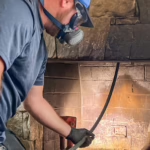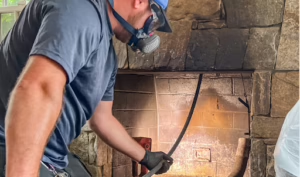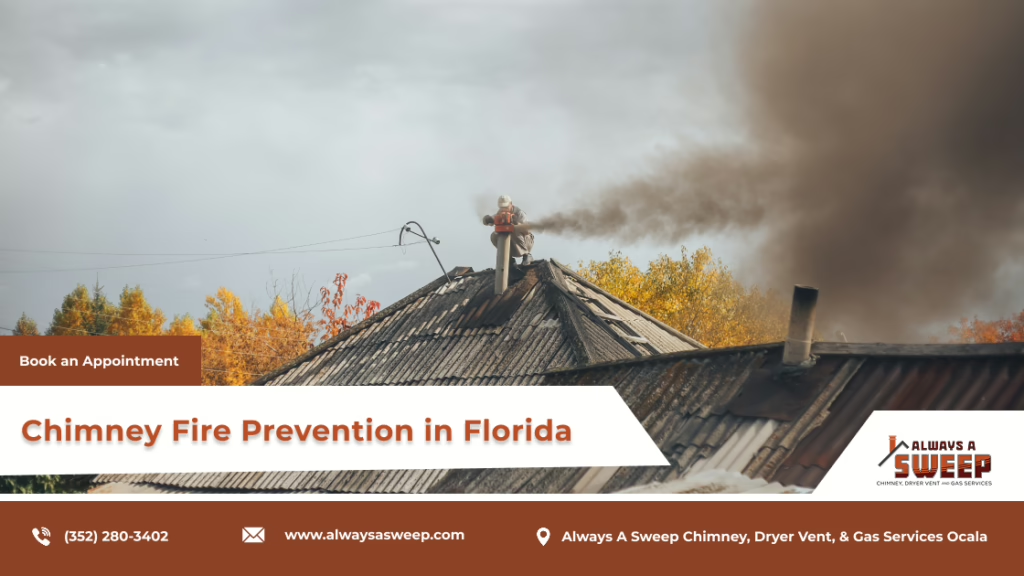Maintaining your chimney is essential for safety and efficiency. Neglecting it can lead to dangerous buildups or even fires. Regular care ensures your chimney remains in great condition all year long. Here are ten straightforward tips for keeping your chimney clean and functional in Orlando’s unique climate.
1. Schedule Regular Inspections
Schedule Regular Inspections Annual chimney inspections are crucial to keeping your fireplace system safe and efficient. These inspections, conducted by certified professionals, can uncover hidden issues such as cracks, blockages, or structural damage that might not be apparent to the untrained eye.
Early identification of these problems can save you from costly repairs and potential safety hazards. It’s especially important to schedule inspections before the colder months, ensuring that your chimney is ready to handle the increased usage during winter. Always Home Sweep emphasizes the importance of timely inspections to give you peace of mind and a functional fireplace.
2. Clean Your Chimney Annually
Clean Your Chimney Annually Scheduling a professional chimney cleaning once a year is vital for maintaining a safe and efficient fireplace. Over time, creosote, soot, and ash build up inside the chimney, increasing the risk of dangerous chimney fires. Creosote, a byproduct of burning wood, is highly flammable and one of the leading causes of chimney-related accidents.
Annual cleaning eliminates this buildup and ensures smooth airflow, preventing harmful gases from lingering inside your home. If your chimney is used frequently, a mid-season cleaning may also be beneficial. Trusting professionals for this task guarantees a thorough cleaning and helps prolong your chimney’s lifespan.
3. Watch for Creosote Buildup
Watch for Creosote Buildup Creosote is a sticky, tar-like substance that forms when wood burns, especially if the firewood is not fully seasoned. Over time, it accumulates on the interior walls of your chimney and can become a significant fire hazard.
Keeping an eye out for signs of creosote buildup is essential. If the layer exceeds 1/8 inch, it’s time to call a professional. Regular monitoring and timely cleaning prevent the risk of chimney fires and ensure your chimney remains efficient. Professionals use specialized tools and techniques to remove creosote effectively, leaving your chimney safe for use.
4. Use Seasoned Firewood
Use Seasoned Firewood The type of firewood you use greatly affects the cleanliness and efficiency of your chimney. Seasoned firewood, which has been dried for at least six months, burns hotter and cleaner than green or freshly cut wood.
High moisture content in green wood produces excessive smoke and accelerates creosote buildup. Storing your firewood properly is equally important. Keep it in a dry, covered area with good air circulation to ensure it dries thoroughly. Using well-seasoned wood reduces residue inside your chimney and enhances the overall efficiency of your fireplace system, making it easier to maintain.
5. Check the Chimney Cap
Check the Chimney Cap The chimney cap might be a small component, but it plays a big role in protecting your chimney. It prevents rain, debris, and even animals from entering the chimney, all of which could cause blockages or damage. Regularly inspect the chimney cap to ensure it’s securely in place and free of rust, cracks, or other signs of wear.
If you notice any issues, replacing the cap is a cost-effective solution to safeguard your chimney. A properly maintained cap not only protects your chimney from external elements but also helps improve airflow and prevents potential damage over time.
6. Test the Draft
Test the Draft Testing your chimney’s draft is a quick and simple way to ensure it’s functioning properly. The draft is what allows smoke and harmful gases to exit your home, keeping the air inside safe to breathe.
To test it, light a small piece of paper in the fireplace and observe the smoke. If the smoke rises smoothly up the chimney, your draft is working as it should. However, if the smoke lingers or spills into the room, there may be a blockage or another issue with the chimney’s airflow. Addressing draft problems promptly helps prevent carbon monoxide buildup and keeps your home safe.
7. Keep the Fireplace Clean
Keep the Fireplace Clean A clean fireplace not only looks better but also improves its efficiency and safety. After each use, remove ashes, debris, and leftover wood to maintain proper airflow. Allow the ashes to cool for at least 24 hours before handling them to avoid accidental burns. Use a metal container with a tight-fitting lid to dispose of the ashes safely.
Regularly cleaning the fireplace also prevents blockages in the chimney caused by excessive debris. A tidy fireplace contributes to better combustion and reduces the chances of smoke or odors lingering in your home.
8. Install a Carbon Monoxide Detector
Install a Carbon Monoxide Detector Chimneys, if not properly maintained, can sometimes leak harmful gases like carbon monoxide into your home. Installing a carbon monoxide detector near your fireplace is a simple yet crucial safety measure. This device alerts you to the presence of this odorless, colorless gas, allowing you to take immediate action.
Test your detector monthly to ensure it’s functioning correctly, and replace the batteries regularly to maintain its effectiveness. Having a working carbon monoxide detector adds an extra layer of protection for your family, especially during the colder months when your fireplace sees more frequent use.
9. Inspect the Masonry
Inspect the Masonry Orlando’s humid climate can cause wear and tear on your chimney’s masonry over time. Regularly inspecting the exterior of your chimney is an important maintenance step. Look for signs of damage such as cracks, crumbling mortar, or discoloration. These issues, if left unaddressed, can lead to structural damage and expensive repairs.
Small problems like minor cracks can often be fixed with sealant or by repointing the mortar, ensuring your chimney remains in good condition. Taking the time to care for your chimney’s masonry not only enhances its appearance but also extends its lifespan and ensures its structural integrity.
10. Avoid Overloading the Fireplace
Avoid Overloading the Fireplace Overloading your fireplace with too much wood might seem like a good way to keep a fire going longer, but it can have negative effects. Excessive wood creates more smoke, heat, and pressure on your chimney, increasing the risk of creosote buildup and chimney fires. Instead, stick to smaller, controlled fires that burn cleanly and efficiently.
This approach ensures better airflow, allowing smoke to exit your home properly and reducing the chances of lingering odors or smoke damage. Maintaining a balanced fire helps preserve the safety and efficiency of your chimney system while keeping your home comfortable and safe.
Conclusion: Keep Your Chimney Safe and Efficient
Maintaining your chimney doesn’t have to be complicated. Following these ten tips ensures your chimney stays clean, safe, and functional. Regular inspections, cleanings, and simple maintenance steps like using seasoned firewood and checking your chimney cap make a significant difference. For expert assistance, trust Always Home Sweep to handle all your chimney needs. Regular care prevents problems and keeps your home cozy and secure.
Contact Always Home Sweep today to schedule your next Orlando Chimney Sweep service!







